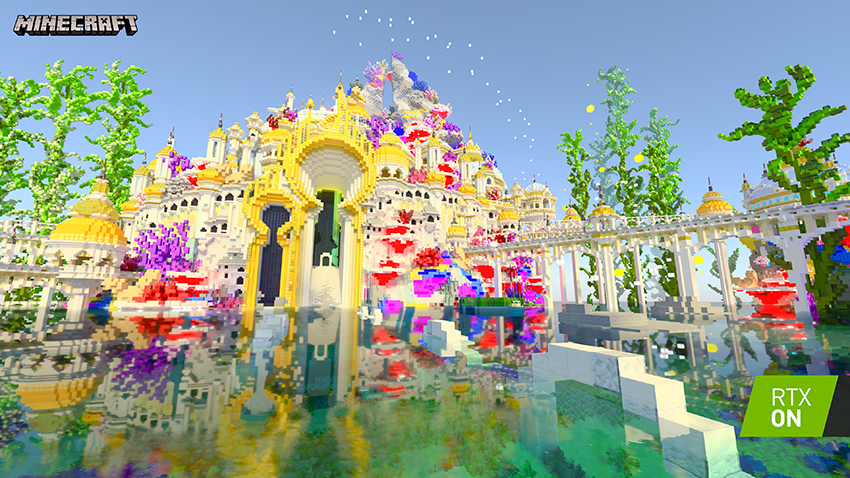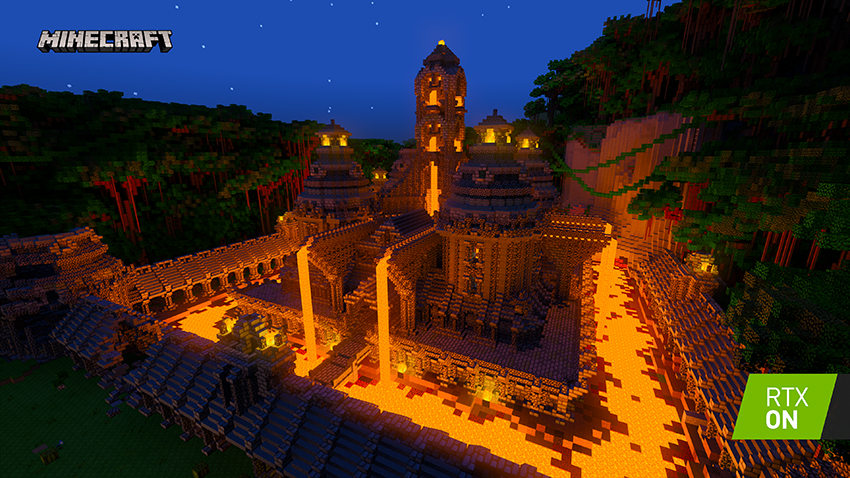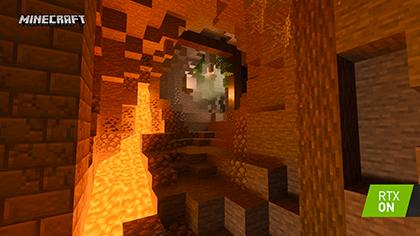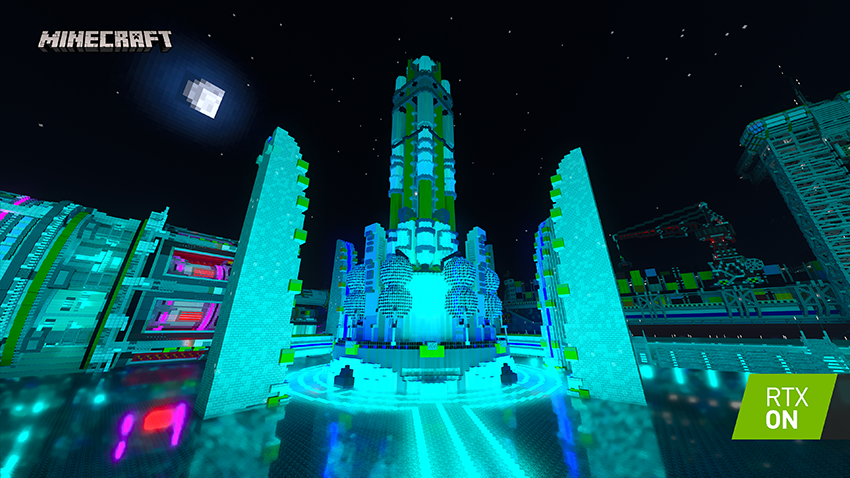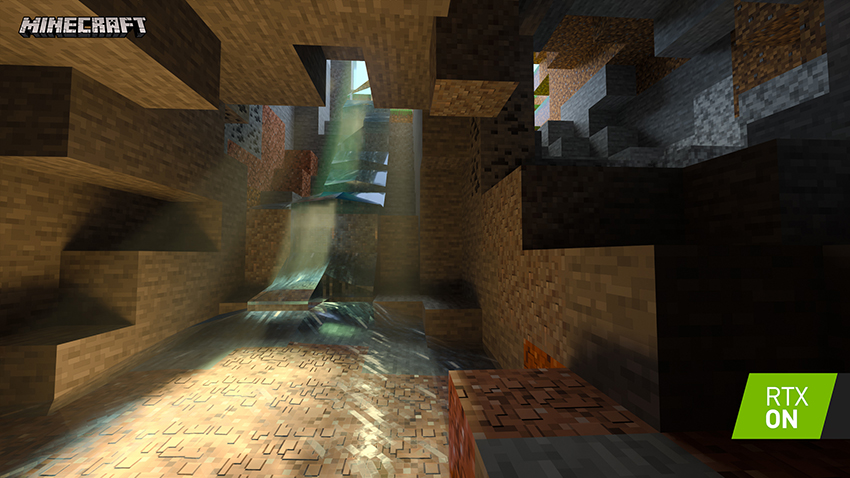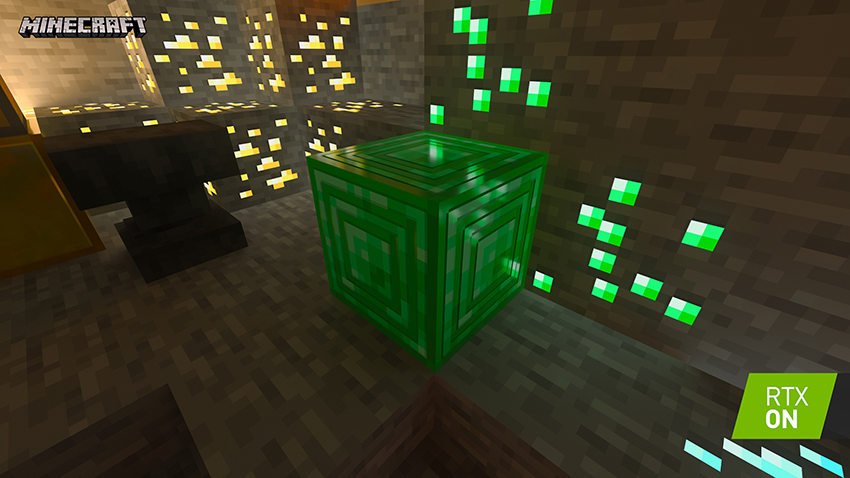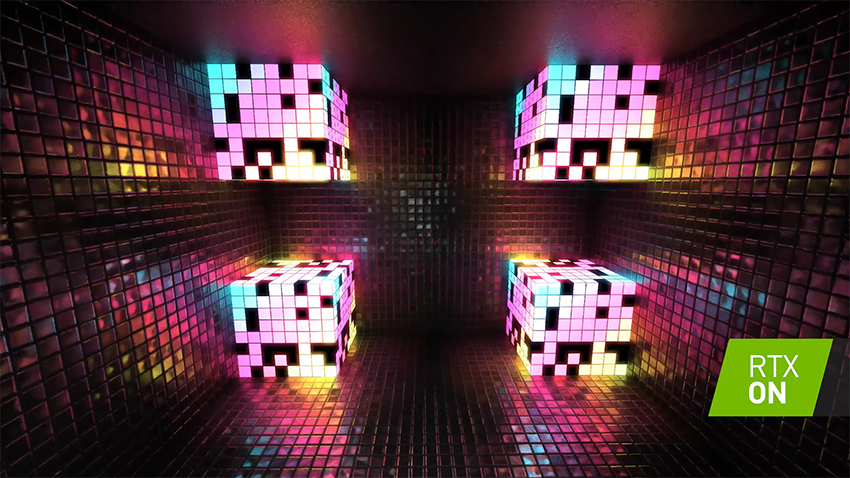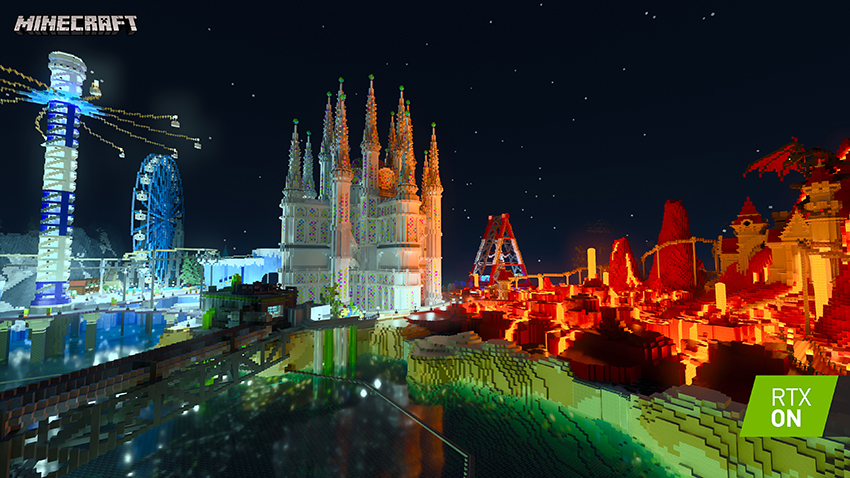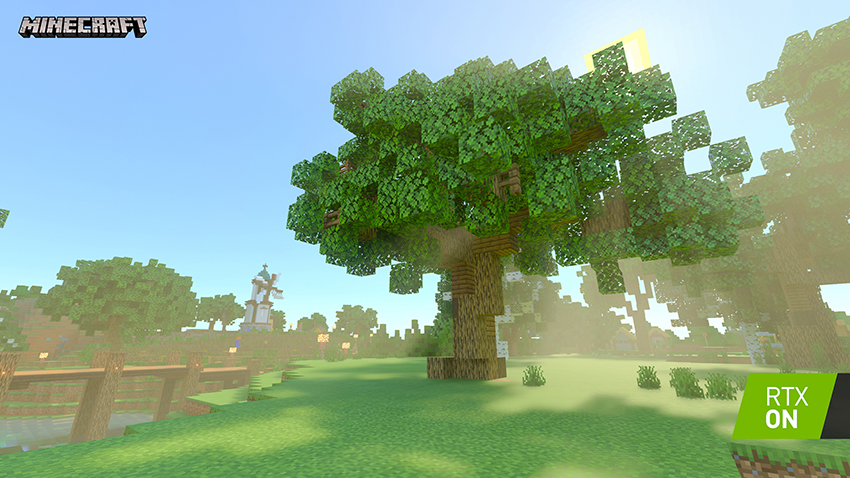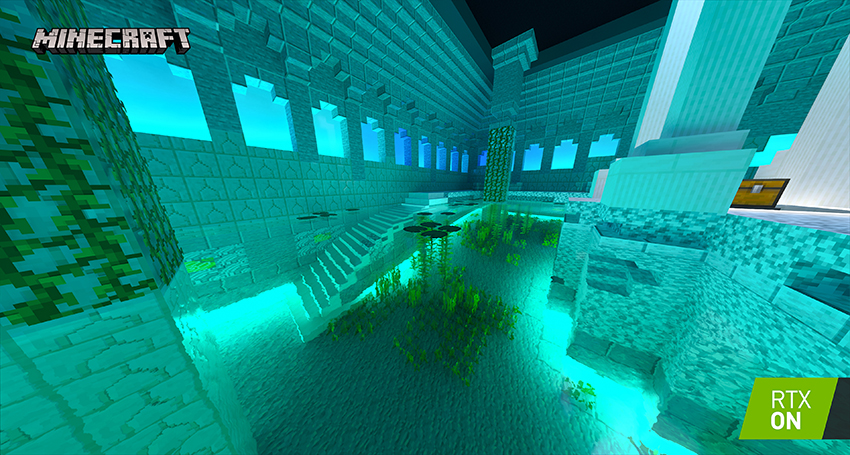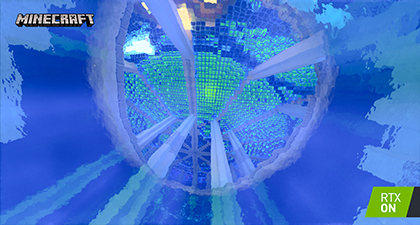Minecraft with RTX Beta Begins April 16, Featuring Ray Tracing and NVIDIA DLSS 2.0
Mark your calendars, the Minecraft with RTX Beta for Windows 10 launches in just two days, on April 16th, 2020! Minecraft with RTX brings fully path-traced rendering, physically-based materials, and NVIDIA DLSS 2.0 to Minecraft, delivering bleeding-edge visual fidelity and realism that can be experienced on all GeForce RTX GPUs.
This beta will launch with 6 RTX Creator Worlds, downloadable for free from the in-game Minecraft Marketplace, that demonstrate the full capabilities of Minecraft with RTX’s new technology.
The results of Minecraft with ray tracing are astounding – realistic hard and soft shadows are seen everywhere; global illumination realistically lights the world, with that light filling interiors through windows and gaps in the terrain; illuminated blocks and other light sources cast pixel-perfect lighting; reflections are seen on all reflective surfaces and blocks, with a level of fidelity far surpassing that of screen space reflections; light reflects, refracts and scatters through water, ice, stained glass, and other transparencies; and atmospheric effects occur naturally, resulting in high quality volumetric fog, and pixel-perfect god rays.
Minecraft with RTX Creator Worlds Demonstrate The Power of Path Tracing
To spark your imaginations, and to demonstrate Minecraft with RTX’s capabilities, we’ve partnered with Minecraft creators from around the planet to bring 6 Creative, Adventure and Survival worlds to the beta, each enhanced with physically-based textures, that you can play for free from April 16th. Let’s take a look at each ray traced world.
World: Aquatic Adventure RTX
Creator: Dr_Bond
Type: Adventure
Download From: Minecraft Marketplace
Lose yourself in this serene underwater world from Dr_Bond, who’s been creating Minecraft worlds and sculptures since 2013. Solve puzzles and explore the depths of the sea underneath the exquisite palace, marvel at the ray-traced god-rays that pierce through the water, and the realistic ray-traced caustics on the ocean floor that create a sense of serenity throughout your time in the world.
“We’ve had RT shaders in the community for such a long time, but to have something infinitely more powerful and robust to me was the true highlight of working with ray tracing in Minecraft with RTX. The reflections and refractions were especially beautiful, and I had tons of fun experimenting with coloured lights underwater to see my projects in a different light. Literally.” – Dr_Bond
World: Of Temples and Totems RTX
Creator: Razzleberries
Type: Adventure
Download From: Minecraft Marketplace
Adventure awaits deep in the ray-traced jungle, designed by Razzleberries and her team. Explore five mysterious elemental temples filled with puzzles, traps and dangerous new foes! Ride elephants, experience god rays galore, and find the ancient totems of each area to help restore peace to the local village.
“Designing a whole adventure experience from the ground up with my team has to be the most satisfying thing ever. What made ray tracing so cool was being able to properly configure materials to interact with lighting in a realistic way that helps bring out the expectations of how the material would really look. Ray tracing will allow map makers and builders to highlight points of interest in their maps, using light to draw the eye.” – RazzleberryFox, CEO of Razzleberries
World: Crystal Palace RTX
Creator: GeminiTay
Type: Survival Spawn
Download From: Minecraft Marketplace
A fantasy castle lies abandoned – explore the Crystal Palace to discover its secrets, find treasure, and defend the village. Designed by GeminiTay, who’s been Minecrafting since 2013, Crystal Palace RTX features innumerable ray-traced shadows, jaw-dropping reflective water, real-time caustics, and many beautiful uses of ray-traced atmospherics to bring new light to Minecraft with RTX.
“RTX in Minecraft really changes the way I think about building in Minecraft altogether. You now have access to the most powerful building tool, light. Using this light to create meaningful scenes and beautiful maps is so incredible. You get to think about the shadow, the rays, where your windows will be, and how the colours will interact. These are things that previously were not thought about nearly enough in the game!
Ray tracing brings Minecraft up a level. The game currently has a very iconic look to it, and without disrupting this, RTX has managed to add a level of depth and detail that I previously couldn't have even imagined. This allows us to think about the way we create in the game differently. Map designers are going to love this.” – GeminiTay
World: Imagination Island RTX
Type: Adventure
Download From: Minecraft Marketplace
BlockWorks was founded 7 years ago by a group of Minecraft builders who met online. They connected over their passion for designing and building in Minecraft, taking the game to its limits as they strove to build ever bigger and more beautiful projects. Now, they have a team with members from all over the world, each bringing their own unique experiences and backgrounds into their collaborative build projects, the latest of which is Imagination Island RTX, an interactive theme park filled with easter eggs and 4 distinct lands to explore, further enhanced by custom PBR textures made by the Blockworks crew.
“Ray tracing shone a new light on building Minecraft environments, quite literally! It really expanded the creative possibilities of the game, and changed the way we think about what a great Minecraft build is. Although it's the same game with the same blocks, being inside an environment with ray tracing is a completely different experience.” – BlockWorks
World: Color, Light and Shadow RTX
Creator: PearlescentMoon
Type: Adventure
Download From: Minecraft Marketplace
Discovery awaits as you experience real-time ray tracing in this captivating interactive world. Discover a magical prism room where you can blend ray-traced coloured lighting in real-time, and unleash your imagination with the power of RTX. Experiment with global illumination, colour theory, reflections and more in this stunning showcase, which includes a unique room with recursive reflections, creating the appearance of an infinity mirror!
“I will always say that I believe ray tracing will improve gameplay functionality and level design in maps. The environment and visual impact that ray tracing allows via improved textures and lighting manipulation opens it up for so many possibilities; as exemplified in my RTX Showcase map. As a player that mains in creative building, I have a high interest in how small details can impact a build in such large ways.” - PearlescentMoon
World: Neon District RTX
Creator: Elysium Fire
Type: Creative
Download From: Minecraft Marketplace
A popular Java Edition world converted to Windows 10, this amazing futuristic city is a sight to behold. True to its name, lights of all colours exhibit per-pixel emissivity made possible by real-time ray tracing. Elysium Fire, known for their incredible time-lapse videos on YouTube, have created a truly awe-inspiring sight for Minecraft players, complete with holograms, dark twisted corridors and a city reflected on the bay, this is a fine technical showcase of Minecraft with RTX.
“RTX will make us (as Minecrafters) rediscover the game graphically. We think this is a good thing because it will bring realism and a new approach to the way of building in Minecraft, because we can now play with lighting effects, shadows and textures.” - Elysium Fire
World: Razzleberries RTX Texture Showcase
Creator: Razzleberries
Purpose: For testing your own texture packs
Download From: Minecraft Wiki, from April 16th when the beta is released
In addition to the 6 world's available from the Minecraft Marketplace, we've worked with Razzleberries to also create a texture showcase that’ll be available from the Minecraft Wiki. See almost every single block, entity and biome in Minecraft, all laid out in exciting dioramas, and marvel at how ray tracing affects them. And should you make your own textures, after following the steps in our PBR Texturing Guide, you can drop into the map to instantly see your textures in action.
Create Your Own Worlds In The Minecraft with RTX Beta
During the Minecraft with RTX Beta, you are able to create new ray-traced worlds from scratch and apply a PBR resource pack (for more details on how, head here). Please note, similar to all Minecraft betas, Realms are disabled.
If, however, you have a favourite Java world you’d like to experience in Minecraft with RTX, or are a world builder looking to breathe new life into your creations, we’ve developed unofficial best-practices to convert your world to Bedrock Windows 10, which is the basis for Minecraft with RTX. It’s all fairly straightforward, but before you convert please ensure you backup your worlds.
Once you’ve completed world conversion, simply copy the world to the Minecraft for Windows 10 world save folder, located in %USERPROFILE%\AppData\Local\Packages\Microsoft.MinecraftUWP_8wekyb3d8bbwe\LocalState\games\com.mojang\minecraftWorlds.
Once you’re up and running, send us screenshots and videos of your world on social media using #Minecraft and #RTXON for a chance to be featured in a Community Showcase (and to win some Minecoins). More details below.
Accelerate Performance With NVIDIA DLSS 2.0
The Minecraft with RTX Beta features one of our newest technologies, NVIDIA DLSS 2.0. This is a revolutionary real-time rendering technique that accelerates performance via AI-based super resolution – the process of rendering fewer pixels and then using AI to construct sharp, higher resolution images that run at much faster frame rates.
Powered by dedicated AI processors called Tensor Cores, available exclusively on GeForce RTX GPUs, NVIDIA DLSS 2.0 is a new and improved, critically-acclaimed version of this technique, used to great effect in several titles, and now Minecraft, too.
In-game, go to Settings --> Advanced Video, and switch on “Upscaling” to enable DLSS 2.0, if it isn’t already active. When enabled, performance instantly increases by up to 1.7x at 1920x1080, and by up to 3x at 4K in the Minecraft with RTX Beta.

At 1920x1080, DLSS is automatically set to “Quality” mode. At 2560x1440, “Balanced”, and at 4K, “Performance”
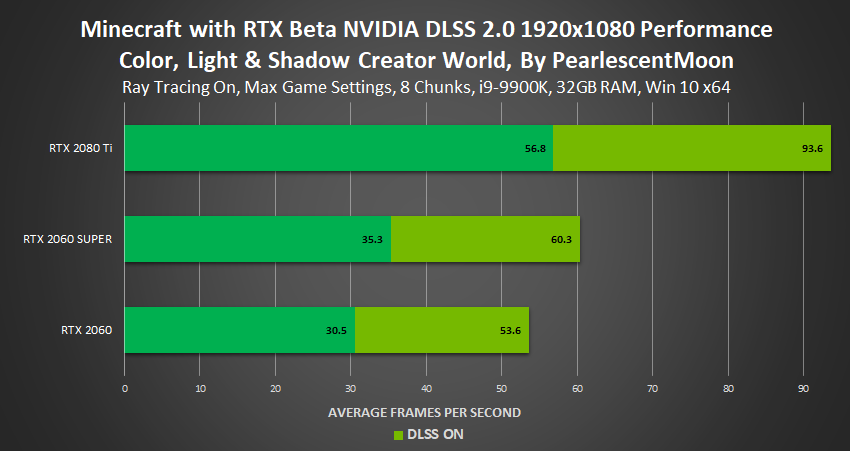
DLSS 2.0 enables smooth frame rates for GeForce RTX 2060 and higher GPUs. Note: Minecraft with RTX is in beta and performance will likely see further optimisation between beta and official release. Performance will vary from world to world based on scene complexity
Most importantly, DLSS achieves these performance gains while keeping image quality comparable to native resolutions. Let’s look at a couple of examples.
In both, captured at 1920x1080, NVIDIA DLSS 2.0 delivers equivalent clarity and detail, while running substantially faster, giving gamers a smoother, more performant experience.
DLSS 2.0 can also improve image quality in certain cases, further improving your experience.
Get Ready For The Beta: Download the Minecraft with RTX Game Ready Driver April 15
For an optimised experience in the beta, we recommend all players install our Minecraft with RTX Game Ready Driver, which will be available from 6am PT on April 15th. For complete details and download links, head to GeForce Experience’s Drivers tab or GeForce.com at that time.
Minecraft with RTX World Sweepstakes: Share Your Best Creations For A Chance To Win
Once the Minecraft with RTX Beta begins on April 16th, you’ll have the chance to win:
- GeForce RTX 2080 Ti graphics cards
- Digital codes worth 1600 Minecoins
- Minecraft Creeper Mega Bobbles
- Minecraft Zombie Plushes
- Steam Digital Gift Cards worth $50
To enter, download any or all of the Minecraft with RTX beta worlds and share high-quality screenshots or videos of your Minecraft with RTX beta experience with ray tracing on to Facebook, Twitter, Instagram, YouTube, or our GeForce forums, and use the #Minecraft and #RTXON in the copy, title or description.
For extra chances to win, follow the GeForce social media channels and complete the Minecraft with RTX prompts – for example, “build a famous place from around the world using ray tracing in Minecraft with RTX, and share screenshots or videos of your creation with #RTXON and #Minecraft.”
You can enter as many times as you like and complete any or all of our prompts for extra chances to win. For full terms and conditions, please head here.
Create Your Own Physically Based Rendering (PBR) Textures
To take full advantage of Minecraft with RTX’s path-traced renderer, we’ve added a physically based materials pipeline that enables the creation of block textures with real-world properties. For example, blocks and textures can feature any degree of reflectivity, and will realistically mirror or reflect surrounding detail using path tracing, for pixel-perfect detail. The surface of gravel and water feels more natural and detailed. And once flat light sources from Glowstone now emits from the individual glowing specks.
Examples of the new hi-res (1024x1024) and vanilla derivative/low res (16x16) PBR textures applied to Minecraft’s blocks in Minecraft with RTX
The Minecraft with RTX Beta Creator Worlds include creator-made PBR resource packs. These upgrade textures to follow the Physically Based Rendering pipeline and are optimised for maximum performance and detail.
In addition to these worlds, NVIDIA is releasing four resource packs. Two, HD Decorative Resource Pack and HD Foundational Resource Pack, are created by NVIDIA. The others, Muddle RTX and RazzleCore RTX, are created by Razzleberries. With these four packs, you will be able to enjoy both high resolution textures (1024x1024) and low resolution textures (8x8 or 16x16) with PBR capabilities.
If, however, you want to make your own PBR textures, or even a complete PBR resource pack, we’ve written a PBR texturing how-to guide with step by step instructions. Check it out here, and watch our GTC presentation for even more info.
Minecraft with RTX’s Path-Traced Effects, In-Depth
As we’ve mentioned, Minecraft with RTX’s worlds are almost entirely path-traced, with lighting and effects featuring unprecedented levels of detail, for the very best image quality possible. If you yearn to know more, and love to geek out about under the hood tech, here’s a rundown of all the major effects.
Global Illumination
Games are traditionally illuminated by precomputed lightmaps, Image-Based Light Probes, Spherical Harmonics, and Reflective Shadow Maps, plus artist-placed lights to help force illumination where the aforementioned techniques fail. And while the results look great, the techniques used have several shortcomings, the biggest of which being that dynamic lighting fails to bounce or illuminate beyond the area that the light hit.
For example, imagine a dark room with bright light shining through a window. With traditional techniques, everything that is directly hit by the light is illuminated, but the illuminated areas themselves do not bounce light, and do not illuminate surrounding game elements, when in reality they would.
With path tracing, we can accurately model the dynamic indirect diffuse lighting reflected by one or more indirect bounces off of surfaces in the scene, and have it interact and interplay with other ray-traced effects. Imagine, for instance, sunlight beaming into a castle through multicoloured stained-glass window blocks, refracting, illuminating all corners of the room, reflecting off the shiny marble floor, and brightening surrounding detail, causing new contact hardening shadows to be cast from objects.
Underground, light beams in, illuminating the darkness, but only to a point - once the light dissipates, make sure you’re carrying a torch or the Creepers will get you! (click to load an interactive RTX ON-OFF comparison)
The results are jaw-dropping, and give us a preview of how all games will eventually be rendered.
Reflections
In Minecraft with RTX, path tracing adds ray traced reflections throughout each world, allowing us to reflect every detail, every mob and NPC, and every other visual effect, for pixel-perfect reflections. And using the PBR texturing system, we can vary the level of reflectivity on different blocks, allowing for a wide range of looks, giving us perfect mirrors, smooth water-based reflections, and surfaces with rough and coarse reflectivity.
Reflectivity helps bring Dr_Bond’s Aquatic Adventure to life, adding reflections to water surfaces, and bouncing light from block to block, illuminating the palace (click to load an interactive RTX ON-OFF comparison)
Inside, PBR textures subtly reflect light from wall to wall, further improving image quality and immersion (click to load an interactive RTX ON-OFF comparison)
With path-traced reflections, not only do you see more detail and information, you experience improved lighting, realism, immersion, and visual fidelity.
Shadows
With our unified path tracing lighting model in Minecraft with RTX, every aspect of each world realistically and naturally casts shadows, and is shaded and darkened by shadows cast upon them. Shadows soften and harden depending on the distance from the shadow caster, mobs, NPCs and new blocks block light and cast new shadows, and newly-placed light sources (torches, illuminated blocks, et cetera) cast new light that creates new dynamic shadows, and affects existing shadows and shading. Most impressive of all, every single leaf in a tree’s leaf block casts its own individual shadow, adding truly wondrous shadow detail to your worlds.
With ray tracing enabled, BlockWorks’ Imagination Island is naturally shadowed, and each shadow has its own intensity and length, as well as realistic contact hardening and contact softening properties (click to load an interactive RTX ON-OFF comparison).
And in Razzleberry’s Of Temples and Totems, individual leaves in leaf blocks cast shadows as god rays pierce the forest’s canopy.
Per-Pixel Emissive Lighting
All torches and light-emitting blocks in Minecraft with RTX have been upgraded with per pixel emissive lighting. This enables each pixel of these items to emit uniquely coloured light that affects their surroundings, best demonstrated by our special disco blocks that display various rainbow colours on an 8x8 grid on each face of each block:
In your worlds, torches will be one of the most noticeable beneficiaries of per-pixel emissive lighting, realistically illuminating their surroundings with fire coloured lighting that subtly varies as each torch burns and flickers. And of course, emitted light will result in new shadows being cast, new reflections being seen, and other path-traced effects being rendered or affected.
BlockWorks’ Imagination Island makes extensive use of emissive blocks to add mood-setting lighting to their rides and attractions (click to load an interactive RTX ON-OFF comparison)
Emissive lava and fire blocks cast appropriate light throughout environments, leading to the creation of new shadows and the application of other ray-traced effects, for even better image quality (click to load interactive RTX ON-OFF comparisons)
Atmospheric Effects
Path tracing introduces new atmospheric effects to Minecraft, enabling players to build and experience worlds with mist and fog, illuminated by sunlight and moonlight, or the occasional torch or lantern, as seen in movies.
Mist and god rays add to the atmospherics of this idyllic area in GeminiTay’s Crystal Palace Creator World (click to load an interactive RTX ON-OFF comparison)
Furthermore, path tracing delivers pixel-perfect dynamic god rays that move and change in step with the sun and moon’s position, and are affected by world geometry and the things you do and build.
God rays are visible above ground and in ocean depths
Transparency Reflection, Refraction and Scattering
As path tracing follows each individual light ray until it dissipates, we can apply immersive and realistic reflection, refraction and scattering to transparencies, such as stained glass, water, and ice. Using these features, you can create ice palaces illuminated exclusively by the sun and moon, and cathedrals with stained glass murals that fill the interior with coloured light as the sun beams through.
These naturally occurring effects can noticeably affect your perception when looking through bodies of water:
Click to load an interactive RTX ON-OFF comparison
And we’ve even modelled Snell’s Window, “a phenomenon by which an underwater viewer sees everything above the surface through a cone of light of width of about 96 degrees. This phenomenon is caused by refraction of light entering water, and is governed by Snell's Law. The area outside Snell's window will either be completely dark or show a reflection of underwater objects by total internal reflection.”
Click to load an interactive RTX ON-OFF comparison
Path tracing’s possibilities in Minecraft with RTX are endless, but if you want a few ideas check out the Creator Worlds mentioned earlier.
Minecraft with RTX Beta: Download and Play On April 16
What more is there to say? Minecraft with RTX is the next evolution of Minecraft, and you can download, test and play the beta starting April 16th at 10 am PT. And from April 15th, you can start getting your system ready by installing the Minecraft with RTX Game Ready Driver.
To learn how to download and install the Minecraft with RTX Beta, return to GeForce.com on the 16th for complete step-by-step instructions.

